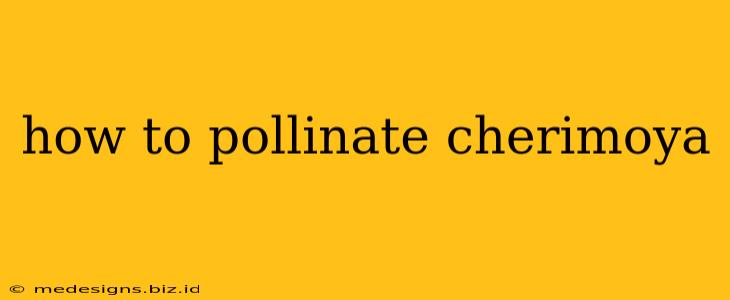Cherimoya, with its creamy, custard-like flesh, is a highly prized fruit. But getting those delicious fruits requires a bit of understanding about its unique pollination needs. Unlike many other fruit trees, cherimoya pollination isn't a simple matter of relying on the wind or insects. Let's dive into the specifics of how to successfully pollinate your cherimoya tree and enjoy a plentiful harvest.
Understanding Cherimoya Pollination: The Challenges
Cherimoya flowers have a fascinating, and sometimes frustrating, reproductive system. They are self-incompatible, meaning that pollen from the same flower or even from the same tree won't result in fruit production. This requires cross-pollination – pollen from a different, compatible cherimoya tree. Furthermore, the flowers possess a unique structure that makes insect pollination challenging.
The Role of Hand-Pollination
Given the complexities of natural pollination in cherimoya, hand-pollination is often the most reliable method to ensure fruit set. This involves manually transferring pollen from one flower to another. While it might seem like extra work, the reward of a healthy crop makes it worthwhile.
Step-by-Step Guide to Hand-Pollinating Cherimoya
Here's a practical guide to hand-pollinating your cherimoya trees for optimal fruit production:
1. Timing is Everything
Cherimoya flowers bloom intermittently throughout the year, but the most important period for pollination is during the main flowering season. Pay close attention to your tree and identify when the flowers are open and receptive to pollen. The flowers typically open in the late afternoon or evening, and the stigmas (female part) are most receptive in the morning.
2. Identifying Male and Female Flower Parts
Cherimoya flowers are hermaphroditic, meaning they have both male (stamens) and female (stigma) reproductive parts. However, these parts don't mature simultaneously. The stamens (pollen-bearing part) typically mature first, followed by the stigma (pollen-receptive part). This asynchronous maturation necessitates cross-pollination.
3. Collecting Pollen
Gently collect pollen from a mature, compatible cherimoya tree using a small, clean brush, cotton swab, or even a toothpick. Focus on stamens that have shed pollen – it will appear as a fine, powdery substance.
4. Applying Pollen to the Stigma
Using the same brush or swab, carefully transfer the collected pollen to the stigma of another compatible cherimoya tree's flower. Ensure good contact between the pollen and the stigma. You can gently rub the pollen onto the stigma to help ensure transfer.
5. Repeat the Process
Repeat the process for multiple flowers on different branches, ensuring cross-pollination between different trees whenever possible.
Choosing Compatible Cherimoya Cultivars
For successful cross-pollination, it's crucial to have at least two different, compatible cherimoya cultivars. Research which cultivars are compatible with yours to maximize your chances of fruit set. A local nursery or agricultural extension office can provide valuable information on suitable cultivars in your area.
Optimizing Your Cherimoya Orchard for Pollination
Beyond hand-pollination, here are some tips to further optimize your cherimoya orchard's pollination success:
- Proper Tree Spacing: Ensure adequate spacing between trees to allow for easy access during hand-pollination.
- Pest and Disease Management: A healthy tree is more likely to produce flowers and fruit. Manage pests and diseases effectively.
- Watering and Fertilization: Provide consistent watering and fertilization to promote healthy growth and flowering.
By following these steps and paying close attention to your cherimoya trees, you can significantly increase your chances of a successful harvest. Happy growing!
